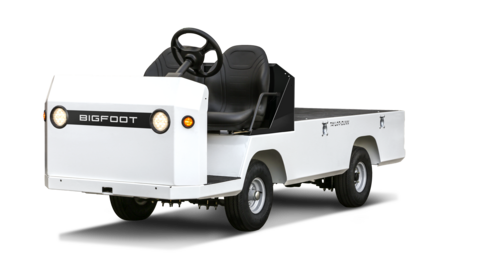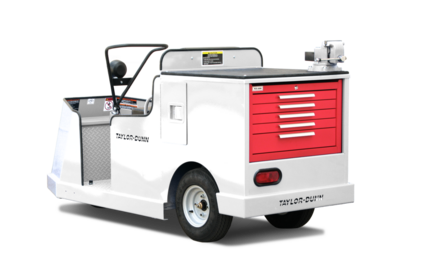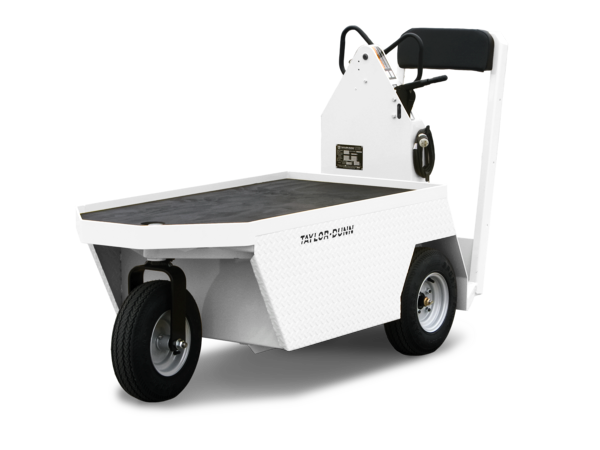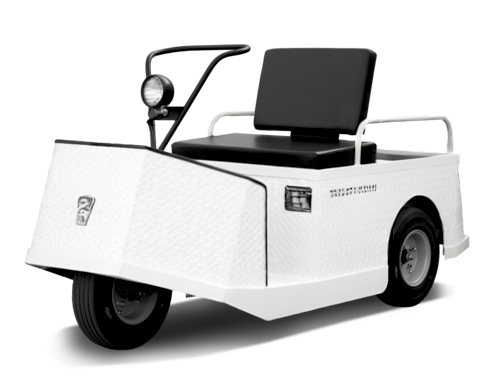Some Taylor-Dunn vehicles show fault codes when a component of the vehicle is malfunctioning. Note that fault codes vary by product line.
Most faults are a result of a fault in the control system that will require service by a qualified Taylor-Dunn Dealer. The faults shown in this article are for reference only.
Fault Codes: BT-280, RE-380 R0-380, C-425, TT-316 DC, E-455, SC-100 24/36/48V, B-200, B-210
The display will indicate a fault code whenever the control system logic detects a problem with the control system. A fault code is being displayed whenever the Fault Code Indicator (the letter “F”) is visible at the left of the numeric display.
Refer to the fault code table below for description of the fault codes.
|
Level 1 Faults |
||
|
Code |
Description |
Recommended Action |
|
F01000 |
P/S Motor Overheated |
Stop the vehicle and allow the system to cool |
|
F01001 |
Motor Brush Fault |
Refer to service technician |
|
F01002 |
Pump Motor Brush Fault |
Refer to service technician |
|
F01003 |
P/S Motor Brush Fault |
Refer to service technician |
|
F01004 |
Low Battery Volts |
Batteries are empty and require charging. If this fault does not reset after the charge cycle is complete then there may be a problem with the charger or batteries. Refer to qualified service technician. |
|
F01005 |
Controller Overheated |
Stop the vehicle and allow the system to cool down. This could be a result of an overloaded vehicle. |
|
F01006 |
Traction Motor Hot |
Stop the vehicle and allow the system to cool down. This could be a result of an overloaded vehicle. |
|
F01007 |
Pump Motor Overheated |
Stop the vehicle and allow the system to cool down. |
|
F01008 |
Wiring Fault |
Refer to service technician |
|
Level 2 Faults |
||
|
Code |
Description |
Recommended Action |
|
F02000 |
Throttle Fault |
Refer to service technician |
|
F02001 |
Throttle Fault |
Refer to service technician |
|
F02002 |
Belly Switch Fault |
Refer to service technician |
|
F02003 |
Open Field |
Refer to service technician |
|
F02004 |
Open Field L |
Refer to service technician |
|
F02005 |
Open Field R |
Refer to service technician |
|
Level 4 Faults |
||
|
Code |
Description |
Recommended Action |
|
F04000 |
Open Contactor |
Refer to service technician |
|
F04001 |
Contactor Welded |
Refer to service technician |
|
F04002 |
Steer POT Fault |
N/A |
|
F04003 |
Sequence Fault |
Start up switches were not operated in the correct order. Refer to Vehicle Operation Guidelines for correct sequence |
|
F04004 |
F&R Fault |
Refer to service technician |
|
F04005 |
F&R Fault |
Direction was selected before start switch was closed. Place direction selector in the OFF position and restart. |
|
F04006 |
Interlock Fault |
Seat or foot interlock switch not closed. |
|
F04007 |
Inch Switch Fault |
Direction Control switch NOT in neutral. |
|
F04008 |
Steer Fault |
Refer to service technician |
|
F04009 |
Low Battery Volts |
Extreme low battery voltage at the controller. May be a result of severely discharged battery or wrong battery installed. Confirm that the correct battery is installed and charge the battery. |
|
F04010 |
High Battery Volts |
Refer to service technician |
|
F04011 |
Out of Range Fault |
Refer to service technician |
|
F04012 |
CRC Fault |
Refer to service technician |
|
F04013 |
Capacitor Fault |
Refer to service technician |
|
Level 5 Faults |
||
|
All Level 5 faults indicate a failure in the motor speed control system. Refer repair to a service technician. |
||
Fault Codes: Bigfoot XL, TT-316 AC
The display on these vehicles will indicate a fault code whenever the control system logic detects a problem with the control system. A fault code is being displayed whenever the Fault Code Indicator (the letter “F”) is visible at the left of the numeric display.
Refer to the fault code table below for a description of possible fault codes.
|
Display |
Flash |
Message |
Action |
|
F10101 |
10 |
Unit in preoperational |
Refer to dealer for repair. |
|
F15101 |
15 |
Vehicle Service Required |
Service the vehicle. |
|
F16010 |
6 |
Seat (warning) |
Operator presence switch is open. Confirm driver seat properly positioned. |
|
F17001 |
7 |
BDI Warning |
Low battery voltage. Charge the batteries. |
|
F17002 |
7 |
BDI Cutout |
Low battery voltage. Charge the batteries. |
|
F17003 |
7 |
Low Battery Cut |
Refer to dealer for repair. |
|
F17004 |
7 |
High Battery Cut |
Refer to dealer for repair. |
|
F17006 |
7 |
Vbat below rated min |
Low battery voltage. Charge the batteries. |
|
F17007 |
7 |
Vbat above rated max |
Refer to dealer for repair. |
|
F17009 |
7 |
Motor in low voltage cutback |
Warning only (not a fault) due to transient low voltage. |
|
F18001 |
8 |
Device too cold |
Move to warmer location |
|
F18002 |
8 |
Device too hot |
Overloaded, allow controller to cool. |
|
F18003 |
8 |
Motor in thermal cutback |
Overloaded, allow controller to cool. |
|
F18004 |
8 |
Motor too cold |
Move to warmer location. |
|
F22001 |
2 |
Seat Fault |
Operator presence switch is open. Confirm driver seat properly positioned. |
|
F22002 |
2 |
Two Direction Fault |
Refer to dealer for repair. |
|
F22003 |
2 |
SRO Fault |
Throttle pedal pressed without direction selected. |
|
F22004 |
2 |
Sequence Fault |
Throttle or direction selected at power up. |
|
F22006 |
2 |
Inch Fault |
Inching switch active along with any drive switch, seat switch indicating operator present or handbrake switch active. |
|
F26001 |
6 |
Throttle Fault |
Refer to dealer for repair. |
|
F35002 |
5 |
Motor Open Circuit Fault |
Refer to dealer for repair. |
|
F35003 |
5 |
No Motor Speed Signal |
Refer to dealer for repair. |
|
F37003 |
7 |
Power Supply Critical |
Refer to dealer for repair. |
|
F41101 |
11 |
DSP Encoder Fault |
Refer to dealer for repair. |
|
F41102 |
11 |
DSP Overcurrent Fault |
Possible overloaded vehicle. |
|
F41103 |
11 |
DSP Control Fault |
Refer to dealer for repair. |
|
F41104 |
11 |
Motor Overspeed Fault |
Uncontrolled coasting downhill or towing at excessive speed. |
|
F44001 |
4 |
Line Contactor o/c |
Refer to dealer for repair. |
|
F44002 |
4 |
Line Contactor Welded |
Refer to dealer for repair. |
|
F46003 |
6 |
Analogue Output Over Current |
Refer to dealer for repair. |
|
F46006 |
6 |
Analogue Output Over Temperature |
Refer to dealer for repair. |
|
F47002 |
7 |
Capacitor Precharge Failure |
Refer to dealer for repair. |
|
F48001 |
8 |
Heatsink Overtemp |
Overloaded, allow controller to cool. |
|
F53001 |
3 |
DSP Overvoltage |
Refer to dealer for repair. |
|
F53002 |
3 |
DSP Powerframe Fault |
Possible overloaded vehicle. |
|
F53003 |
3 |
MOSFET s/c M1>B+ |
Refer to dealer for repair. |
|
F53004 |
3 |
MOSFET s/c M1>B- |
Refer to dealer for repair. |
|
F53005 |
3 |
MOSFET s/c M2>B+ |
Refer to dealer for repair. |
|
F53006 |
3 |
MOSFET s/c M2>B- |
Refer to dealer for repair. |
|
F53007 |
3 |
MOSFET s/c M3>B- |
Refer to dealer for repair. |
Fault Codes: SC-090 AC and R-380 AC
Only shown are the DTCs (faults) caused by the operator or correctable by the operator. There are many other codes; those not listed here cannot be corrected by the operator and must be referred to a qualified technician.
|
DTC Code |
Cause |
Resolution |
|
12 |
Overloaded |
Reduce load on vehicle |
|
16 |
Control overheated |
Allow controller to cool |
|
17 |
Battery low (severe) |
Charge battery |
|
18 |
High Battery Voltage |
Possible due to coasting down grade with full battery charge. Use brakes to control speed down hill. |
|
21 |
Too Cold |
Operating with temperatures below -25 C result in power cutback |
|
22 |
Overheating |
Reduce load |
|
23 |
Battery low |
Charge battery |
|
24 |
High Battery Voltage |
Possible due to coasting down grade with full battery charge. Use brakes to control speed down hill. |
|
28 |
Motor overheating |
Reduce load |
|
47 |
Operator sequence error |
Operate switches in correct order |
|
51 |
Throttle and Brake pedals pressed at same time |
Release brake pedal |
|
52 |
|
|
|
54 |
Maintenance due soon |
Have vehicle serviced |
|
55 |
Maintenance due now |
Have vehicle serviced |
|
58 |
Throttle pressed before direction selected |
Operate switches in correct order |
|
59 |
Throttle pressed before OPS closed |
Operate switches in correct order |
|
64 |
Charger connected |
Disconnect the charger |
|
73 |
Motor stalled |
Reduce load |
Fault Codes: 426 AC, SC-100 AC
If the system detects a fault, an abbreviated fault message will be displayed. Refer to the table below.
|
Fault Code |
Description |
Note |
|
CRTL FLT |
Speed controller internal fault or wiring fault |
1 |
|
CRTL TMP |
Speed controller overheated |
3 |
|
EMB FLT |
Electric brake fault |
1 |
|
FB OR |
Foot brake switch is closed |
1 |
|
HIGH V |
High battery voltage |
|
|
LOCK |
Electromagnetic motor brake is applied |
|
|
LOW V |
Low battery voltage |
|
|
MOTR TMP |
Motor overheated |
3 |
|
MOTR FLT |
Faulty motor or wiring |
1 |
|
SEAT OFF |
Seat interlock switch is open |
1 |
|
SRO FLT |
Operator error |
2 |
|
STALL |
Motor stalled |
4 |
Fault Codes: TC-50E
Any active faults will be displayed at the bottom of the display screen. This fault listing is limited to faults that are generated by operator error or faults that are a result of system operation that can be corrected by the operator. If a fault occurs that is not listed here, then vehicle diagnostics and repair should be referred to a qualified technician.
|
Fault ID |
Fault Display |
Definition |
Possible Cause |
|
4481 |
Handbrake fault |
Parking brake was applied when throttle pedal was depressed |
Parking brake applied. |
|
45C1 |
BDI Warning |
Battery discharged below warning threshold voltage |
Battery is getting low on charge |
|
45C2 |
BDI Cutout |
Battery empty |
The battery is empty and requires charging. Vehicle speed is reduced to protect the battery and control system from low voltages. |
|
45C3 |
Low Battery Cut |
Battery voltage dropped below protection threshold voltage |
Possibly an overloaded vehicle. Vehicle speed is reduced to protect the battery and control system from low voltages. |
|
4602 |
Device is too hot |
Controller internal temperature exceeded high temperature threshold |
Motor speed controller has overheated. Reduce the load or stop until temperature is reduced. |
|
4603 |
Motor in thermal cutback |
Motor temperature exceeded high temperature threshold |
Motor has overheated. Reduce the load or stop until temperature is reduced. |
|
4881 |
Seat Fault |
Seat or foot interlock switch open when throttle pedal was pressed. |
Driver must remain seated while operating vehicle. If equipped with a foot switch, the switch must remain depressed. |
|
4883 |
SRO Fault |
Startup switches operated out of order. |
All operator switches must be actuated in the correct sequence. |
|
4884 |
Sequence Fault |
Startup switches operated out of order. |
All operator switches must be actuated in the correct sequence. |
|
4885 |
FS-1 Recycle Fault |
Startup switches operated out of order. |
All operator switches must be actuated in the correct sequence. |
|
4886 |
Inch Fault |
Problem with Inching Buttons |
Refer to the operation instructions of the inching buttons in the Vehicle Operator and Service Manual. |
Fault Codes: TT-416
Only shown are the DTCs (faults) caused by the operator or correctable by the operator. There are many other codes; codes not listed here cannot be corrected by the operator and must be referred to a qualified technician.
|
DTC Code |
Cause |
Resolution |
|
12 |
Overloaded |
Reduce load on vehicle |
|
16 |
Control Overheated |
Allow controller to cool |
|
17 |
Battery Low (Severe) |
Charge battery |
|
18 |
High Battery Voltage |
Possible due to coasting down grade with full battery charge. Use brakes to control speed down hill. |
|
21 |
Too Cold |
Operating with temperatures below -13 degrees Fahrenheit (-25 degrees Celsius) results in power cutback |
|
22 |
Overheating |
Reduce load |
|
23 |
Battery Low |
Charge battery |
|
24 |
High Battery Voltage |
Possible due to coasting down grade with full battery charge. Use brakes to control speed down hill. |
|
28 |
Motor Overheating |
Reduce load |
|
47 |
Operator Sequence Error |
Operate switches in correct order |
|
51 |
Throttle and Brake pedals pressed at same time |
Release brake pedal |
|
52 |
Battery Door Off |
Confirm battery doors properly installed |
|
54 |
Maintenance Due Soon |
Have vehicle serviced |
|
55 |
Maintenance Due Now |
Have vehicle serviced |
|
58 |
Throttle pressed before direction selected |
Operate switches in correct order |
|
59 |
Throttle pressed before OPS closed |
Operate switches in correct order |
|
64 |
Charger connected |
Disconnect the charger |
|
73 |
Motor Stalled |
Reduce load |
Fault Codes: Model SS and MX (Curtis DC), C-432, B-150 and MX-1600
The fault light will turn ON and flash a fault code only if an abnormal charging condition has occurred. Note: Critical faults will be accompanied with an audible beeping.
Refer to the fault code table for your vehicle’s charger for more information.
|
Charging with Signet Model HBS Charger |
||
|
Fault Code |
Description |
Action Required |
|
1 (No Flash) |
Time Out |
The charging cycle did not complete when expected. This could be due to deep discharge or faulty batteries. If the fault reoccurs, have the batteries tested by a qualified technician. |
|
2* |
Open circuit or reverse polarity to the battery |
Check the charger connections to the battery. |
|
3* |
Battery voltage too high |
Wrong charger installed. Confirm that the charger voltage matches the battery voltage. |
|
4 |
Charger overheated |
Check for dirt, mud, or other debris on the charger cooling fins and clean as needed. |
|
5* |
AC line voltage out of range |
**Check the input AC line voltage. The voltage must be within 85-135 VAC or 170-264 VAC |
|
6 |
Low battery voltage |
Battery discharged too deeply, faulty battery, or incorrectly wired battery. The charger will operate in low current mode until the battery voltage is up to a normal level then resume normal charging. If this fault does not reset, have the battery tested by a qualified technician and check the battery wiring. |
|
* |
These faults will be accompanied by an audible beep and indicates that the charging cycle was terminated prematurely. |
|
|
** |
Only a qualified electrician should check the AC line voltage. |
|
|
Charging with the Signet Model HB Charger |
||
|
Error Code |
Description |
Action Required |
|
1* |
Reverse polarity or open circuit to the batteries |
Check wiring for corrosion, loose connections, broken wires and proper connection to the batteries. |
|
2 |
AC line voltage too high or too low |
Check the input voltage. It must be within 96-132VAC or 196-266VAC. |
|
3 |
Charger overheated |
Wait for charger to cool, the charger will automatically restart. Inspect for dirt or debris on the charger cooling fins and clean as required. |
|
4 |
Input or Output over current |
Charger will automatically correct for this condition and restart. |
|
Charging with the Summit Charger |
|||
|
Fault Lamp |
Status Lamp |
Complete Lamp |
Fault Description |
|
Slow flash |
OFF |
ON |
Charger overheated |
|
Slow flash |
ON |
OFF |
Battery voltage below 10v |
|
Slow flash |
OFF |
OFF |
AC power interrupted. This fault will only display for one minute and then clear. |
|
Slow flash |
ON |
Slow flash |
Charger internal fault |
|
Slow flash |
Slow flash |
OFF |
Charger internal fault |
|
Slow flash |
Slow flash |
ON |
Charger internal fault |
|
Fast flash |
– |
– |
Charger internal fault |
|
The following conditions are an indication of battery problems |
|||
|
ON |
OFF |
OFF |
Time out: One or more charging phases exceeded a time limit. |
|
ON |
OFF |
Slow flash |
Battery voltage exceeded threshold indicating one or more faulty batteries. |
|
ON |
Slow flash |
OFF |
Time out: Possible too large AH battery installed. |
|
ON |
Slow flash |
Slow flash |
Time out: Total charging time exceeded a time limit indicating one or more faulty batteries. |
|
Charging with the Summit II Charger |
|||
|
Fault Lamp |
Status Lamp |
Complete Lamp |
Fault Description |
|
Slow flash |
OFF |
ON |
Charger overheated |
|
Slow flash |
Fast flash |
Slow flash |
Unable to start due to temperature below -25 Celsius. Cycle will start when temperature rises. |
|
Slow flash |
ON |
OFF |
Battery voltage below 10v |
|
Slow flash |
OFF |
OFF |
AC power interrupted. This fault will only display for one minute and then clear. |
|
Slow flash |
ON |
Slow flash |
Charger internal fault |
|
Slow flash |
Slow flash |
OFF |
Charger internal fault |
|
Slow flash |
Slow flash |
ON |
Charger internal fault |
|
Fast flash |
– |
– |
Charger internal fault |
|
The following conditions are an indication of battery problems. |
|||
|
ON |
OFF |
OFF |
Time out: One or more charging phases exceeded a time limit. |
|
ON |
OFF |
Slow flash |
Battery voltage exceeded threshold indicating one or more faulty batteries. |
|
ON |
OFF |
ON |
Battery voltage too low indicating one or more faulty batteries. |
|
ON |
Slow flash |
OFF |
Time out: Possible too large AH battery installed. |
|
ON |
Slow flash |
Slow flash |
Time out: Total charging time exceeded a time limit indicating one or more faulty batteries. |
|
Charging with the X Series Charger |
||
|
Fault LED |
Status LED |
Action Required |
|
OFF |
OFF |
No faults found |
|
Flashing |
Flashing |
|
|
ON |
ON or Dim |
*Faulty charger |
|
Flashing |
ON |
*Faulty charger |
|
ON |
Flashing |
|
|
ON |
ON |
*Faulty charger |
|
Flashing |
OFF |
***Charger programmed incorrectly |
|
* |
Refer charger repair to a qualified technician. |
|
|
** |
Only a qualified electrician should check the AC line voltage. |
|
|
*** |
Continue use of the charger may damage your batteries. Refer charger repair to a qualified technician. |
|
Fault Codes: G-100
Diagnostic Display Mode:
The EFI diagnostic display mode is for informational purposes only. Your Taylor-Dunn dealer can provide for all major repairs.
The diagnostic mode is accessible only when the check engine warning indicator activates after the key has been turned on. Leave the key on if you want to view the active code (failure code).
The diagnostic mode becomes inaccessible if the key is turned off and on and the warning indicator is no longer active. This allows the determination of persistent as well as intermittent faults.
Inactive codes are stored in the history of the unit.
Engine Error Codes
The error screen displays only when the CHECK ENGINE light is on or when it goes on and off during one ignition cycle. Error codes are not stored. When the key is turned OFF, the code and message is lost, but will reappear if the fault reoccurs after restarting the engine.
If the CHECK ENGINE light illuminates, retrieve the error codes from the display.
1. If the error codes are not displayed, use the MODE button to toggle until “Ck ENG” displays on the main line of the display.
2. Press and hold the MODE button to enter the diagnostics code menu.
3. Record the three numbers displayed in the gear position, clock and odometer displays.
4. Press the MODE button to advance to the next error code.
5. Press and hold the MODE button to exit the diagnostics code menu.
6. Your authorized Taylor-Dunn dealer can provide code details and diagnosis.
For full details on fault codes, refer to your Vehicle Operator and Service Manual.
To service a fault code, contact your authorized Taylor-Dunn Dealer. To find a dealer near you, use the Dealer Locator.



